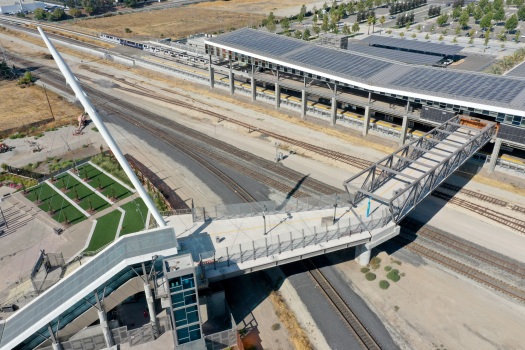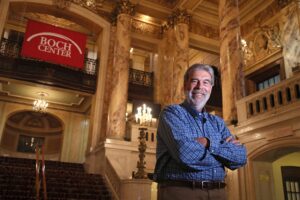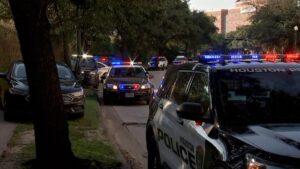FREMONT — After several delays, a $41 million BART Warm Springs pedestrian bridge aimed at directly connecting thousands of residents and workers to one of the newest transit stops in the region is now expected to open this fall.
The bridge — which includes a steel truss portion and cable-stayed section connected to a massive white 110-foot pointed pylon — is about 250 feet long and crosses over several Union Pacific Railroad tracks.
Those tracks block access to the BART station from the west, near the Tesla main factory, along with other large businesses, and thousands of homes, apartments, and commercial and office spaces which are being built or are planned in the city’s “Innovation District.”
Since the Warm Springs/South Fremont BART station opened in 2017, commuters who either live or work on the west side of it have to walk, bike, or drive in a circuitous route around the tracks, or take a private company shuttle.
“Clearly it’s not ideal,” Paul Medved, a capital projects manager for BART, said. “You can’t just walk in a straight line. It will definitely be better to have that western entrance.”

The bulk of the construction on the West Access Bridge and Plaza by Oakland-based contractor Shimmick has been completed for about six months, including the placement of the bridge structures and the paving and sculpting of a plaza at its base with public art and amphitheater seating that could host live entertainment and farmers markets, among other events.
Since then, Fremont and BART officials said Shimmick has been working to integrate and later test the project’s electronics and emergency systems with the transit agency — a familiar issue that has caused delays on previous BART projects, including the Warm Springs station itself.
“We recognize the public and others are eager to see, ‘Hey, when can we get onto the bridge and start using it,’ and we certainly empathize with that,” Hans Larsen, Fremont’s public work’s director said in an interview.
“We do acknowledge the project has taken longer than initially expected. It’s really a function of the degree of complexity the project has.” The landmark public works project initially was anticipated to open as early as fall 2018.
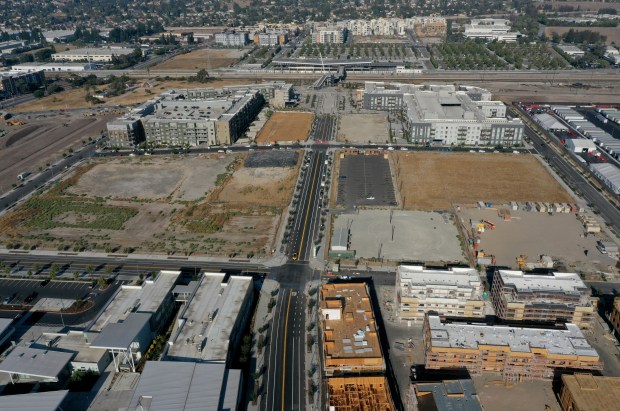
The project was first delayed before it ever broke ground, when Fremont received construction bids more than $4 million over the city engineer’s estimate in 2017. That caused nearly a year of delay as the city asked the Alameda County Transportation Commission for more tax Measure BB funds, and dealt with a bid protest from a contractor.
But Larsen says more recent delays have included trouble with getting the box truss bridge segment to the project site, after it was assembled in Washington state.
“There had been an expectation they’d be able to truck this down Interstate 5,” Larsen said, but unforeseen Caltrans work along that route made it impassable for an oversized load-bearing truck.
“So it required finding and figuring out a detour route for this through the states of Idaho and Nevada where there was sufficient space to get this large oversized load that basically required lane closures and a big convoy of equipment to be able to get it to the site.”

Larsen said the bridge shipping delay of several months also threw off the schedule to install it, which required Union Pacific to close down their rail operations temporarily.
“So our advance coordination with Union Pacific got impacted…and then we sort of had to start all over with them,” he said. “Union Pacific has been a very cooperative partner, but their priorities as an organization don’t necessarily align with our priorities to get the bridge up.” .
And because all the electronic systems that connect to BART get routed through the bridge, its delay created a “cascading effect on the schedule,” Larsen said.
Even though riders may not see many workers swarming the site currently, work is being done, much of which involves “the communications between the elevator, escalator, fire alarm, sprinklers, the gates, and security cameras” and documenting it all, Larsen said.
“It’s just like if you buy a new car, you get an operations manual, an owners manual that comes with it,” he said.

BART’s Medved said contractors often struggle when it comes to meeting BART requirements for integrating with its systems, especially a project like this with a bevy of cameras and remote controlled elements.
“There’s a lot to it, even with just an entrance. It’s all got to work and be controlled back to the station agent booth, but also back to (BART’s Operations Control Center) in Oakland,” Medved said.
Once open, the benefits for workers in the area could be significant. Many thousands of Tesla employees, for example, could have an easier time getting to the station on foot or bike, especially if Tesla opens a “shortcut” entrance at its factory rear, much closer to the bridge, something Larsen said the company has expressed interest in.
For Jack Chen, a San Francisco resident who has commuted on BART for about eight years to a semiconductor firm in South Fremont, the delay of the bridge opening feels just as frustrating to him as when the Warm Springs station was delayed by roughly two years.
“Because before Warm Springs was open, I used to just drive by and watch nothing happening,” Chen said.
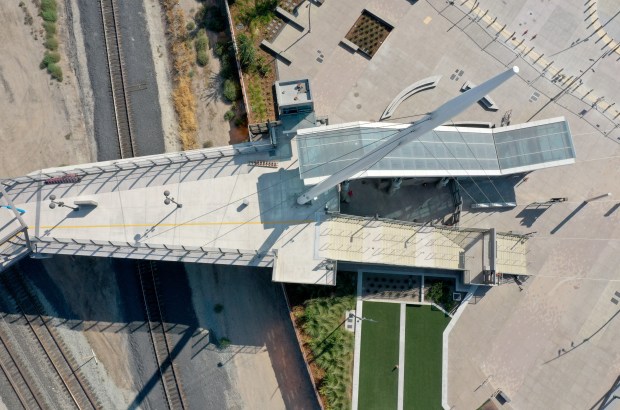
“And now for the bridge, I don’t see any activity for the last six months. It’s just been sitting there and there’s this plywood board blocking us from using the bridge. I just want to walk down that stairway.”
He currently rides BART to Warm Springs, and then uses a bike to get the remaining roughly two miles to work. By mid-October, it’ll be too dark for him to feel safe biking back to BART when he has to cross multiple streets — some with shoddy sidewalks — and he said he’ll start driving to work again.
With two projects involving BART in the city of Fremont delayed back to back, he’s hoping lessons are being learned before the two public agencies embark on building the planned Irvington BART station.
“I don’t expect things to work perfectly. But how can BART and how can the city of Fremont engineering department learn from this,” he said, “so their next big project runs a lot smoother?”

